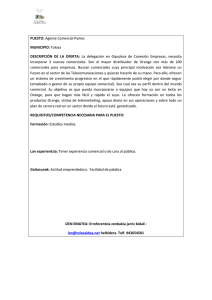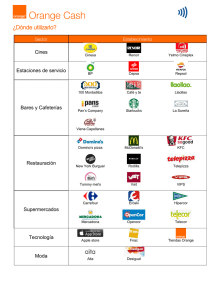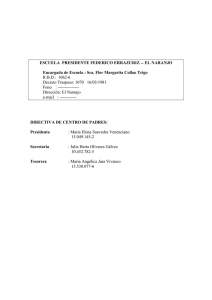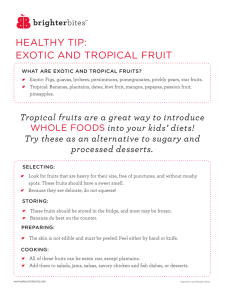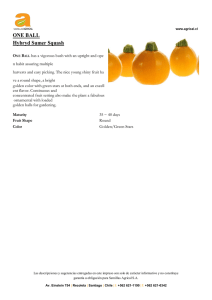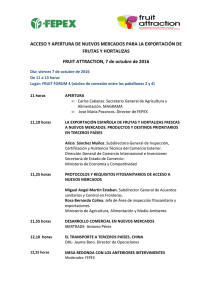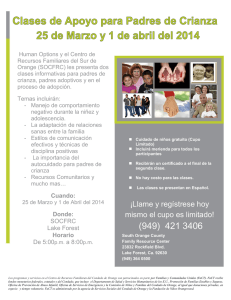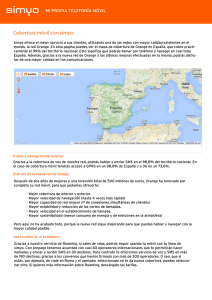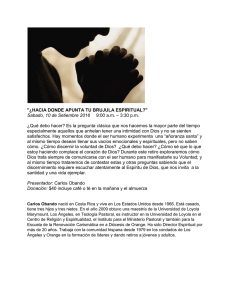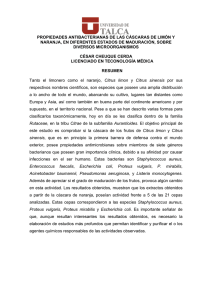Calidad de naranja Valencia injertada en 20 portainjertos
Anuncio
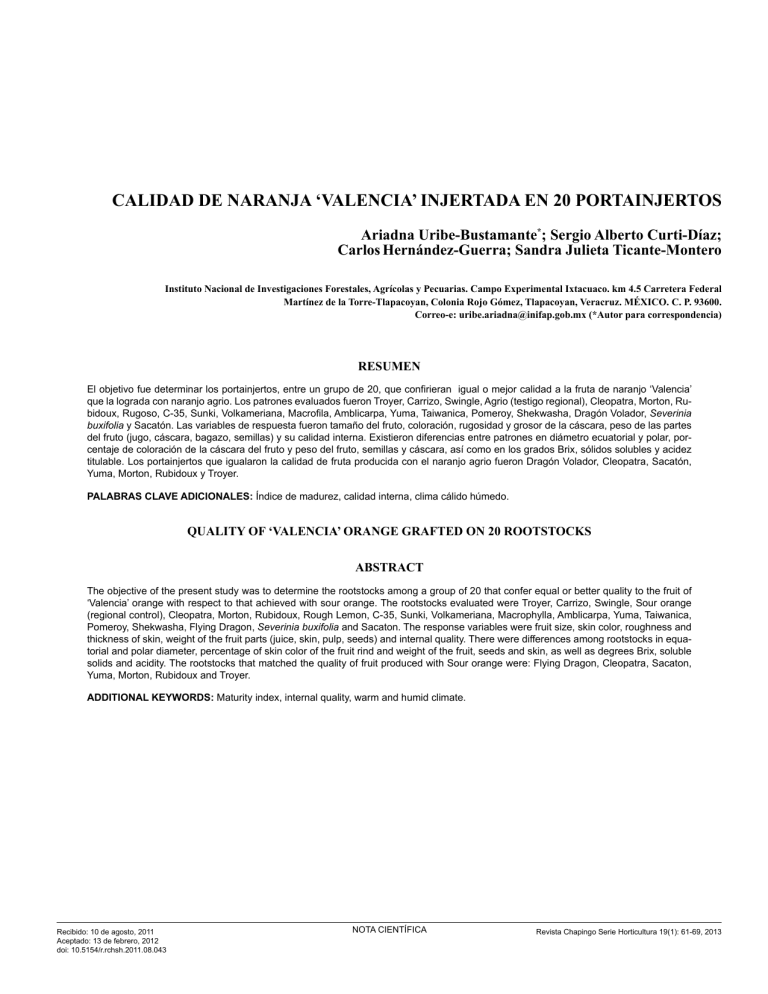
61 CALIDAD DE NARANJA ‘VALENCIA’ INJERTADA EN 20 PORTAINJERTOS Ariadna Uribe-Bustamante*; Sergio Alberto Curti-Díaz; Carlos Hernández-Guerra; Sandra Julieta Ticante-Montero Instituto Nacional de Investigaciones Forestales, Agrícolas y Pecuarias. Campo Experimental Ixtacuaco. km 4.5 Carretera Federal Martínez de la Torre-Tlapacoyan, Colonia Rojo Gómez, Tlapacoyan, Veracruz. MÉXICO. C. P. 93600. Correo-e: [email protected] (*Autor para correspondencia) RESUMEN El objetivo fue determinar los portainjertos, entre un grupo de 20, que confirieran igual o mejor calidad a la fruta de naranjo ‘Valencia’ que la lograda con naranjo agrio. Los patrones evaluados fueron Troyer, Carrizo, Swingle, Agrio (testigo regional), Cleopatra, Morton, Rubidoux, Rugoso, C-35, Sunki, Volkameriana, Macrofila, Amblicarpa, Yuma, Taiwanica, Pomeroy, Shekwasha, Dragón Volador, Severinia buxifolia y Sacatón. Las variables de respuesta fueron tamaño del fruto, coloración, rugosidad y grosor de la cáscara, peso de las partes del fruto (jugo, cáscara, bagazo, semillas) y su calidad interna. Existieron diferencias entre patrones en diámetro ecuatorial y polar, porcentaje de coloración de la cáscara del fruto y peso del fruto, semillas y cáscara, así como en los grados Brix, sólidos solubles y acidez titulable. Los portainjertos que igualaron la calidad de fruta producida con el naranjo agrio fueron Dragón Volador, Cleopatra, Sacatón, Yuma, Morton, Rubidoux y Troyer. PALABRAS CLAVE ADICIONALES: Índice de madurez, calidad interna, clima cálido húmedo. QUALITY OF ‘VALENCIA’ ORANGE GRAFTED ON 20 ROOTSTOCKS ABSTRACT The objective of the present study was to determine the rootstocks among a group of 20 that confer equal or better quality to the fruit of ‘Valencia’ orange with respect to that achieved with sour orange. The rootstocks evaluated were Troyer, Carrizo, Swingle, Sour orange (regional control), Cleopatra, Morton, Rubidoux, Rough Lemon, C-35, Sunki, Volkameriana, Macrophylla, Amblicarpa, Yuma, Taiwanica, Pomeroy, Shekwasha, Flying Dragon, Severinia buxifolia and Sacaton. The response variables were fruit size, skin color, roughness and thickness of skin, weight of the fruit parts (juice, skin, pulp, seeds) and internal quality. There were differences among rootstocks in equatorial and polar diameter, percentage of skin color of the fruit rind and weight of the fruit, seeds and skin, as well as degrees Brix, soluble solids and acidity. The rootstocks that matched the quality of fruit produced with Sour orange were: Flying Dragon, Cleopatra, Sacaton, Yuma, Morton, Rubidoux and Troyer. ADDITIONAL KEYWORDS: Maturity index, internal quality, warm and humid climate. Recibido: 10 de agosto, 2011 Aceptado: 13 de febrero, 2012 doi: 10.5154/r.rchsh.2011.08.043 NOTA CIENTÍFICA Revista Chapingo Serie Horticultura 19(1): 61-69, 2013 62 INTRODUCCIÓN En México se ha estudiado muy poco la calidad de la naranja, definida por su contenido de jugo, sólidos solubles totales (SST), acidez titulable y relación entre sólidos solubles totales y la acidez, cuyos valores estándares, según la norma “México Calidad Suprema”, deben ser un mínimo de 40 %, 10 °Brix, entre 0.5 a 0.8 % y una relación igual a 12.5, respectivamente (Anónimo, 2004). La calidad de la fruta cambia en función de diversos factores, por lo que es importante determinarla en cada una de las áreas agroecológicas del país. Un ejemplo contrastante que fundamenta la necesidad de explorar la calidad de la fruta en diversos ambientes son los resultados obtenidos por Curti-Díaz et al. (1998) en Álamo, Veracruz y Medina-Urrutia et al. (2007) en Tecomán, Colima, quienes evaluaron la calidad del fruto del naranjo ‘Valencia’ injertado en naranjo agrio. En el primer sitio, donde el clima es cálido húmedo y la temperatura media anual es 24 °C, la relación SST/Acidez de 8.5 se obtuvo en febrero, mientras que en Colima, donde el ambiente corresponde al trópico seco y la temperatura media anual es de 27 °C, dicha relación se logró en octubre, cuatro meses antes que en Veracruz. Otro factor que modifica, no sólo el desarrollo vegetativo y rendimiento del árbol, sino que también la calidad externa e interna de la fruta, es el portainjerto que se utilice. De acuerdo con Blondel (1974), está altamente demostrado que el portainjerto que induce un mayor desarrollo de copa generalmente incrementa también el contenido de jugo en su fruta. Monteverde et al. (1991) evaluaron la calidad del fruto del naranjo ‘Valencia’ de 11 años de edad, injertado en seis patrones, y señalan que no hay patrón perfecto, pues mientras que con Volkameriana se obtuvo el fruto más pesado, Cleopatra indujo el mayor porcentaje de jugo y de acidez, y Taiwanica logró el mayor porcentaje de sólidos solubles totales (SST), aunque no hubo diferencias en el grosor de la cáscara y en la relación SST/Acidez. Los otros patrones fueron Rangpur, Rugoso y naranjo agrio. En cambio, Montilla y Gallardo (1994) no encontraron diferencia en la relación SST/Acidez entre los mismos patrones señalados por Monteverde et al. (1991). A raíz de la aparición del Virus de la Tristeza de los Cítricos (CTV) en México, productores y técnicos empezaron a probar diversos patrones injertados con los principales cultivares de cítricos, con la finalidad de reemplazar al naranjo agrio, que hasta ahora es el principal patrón usado, pero es muy sensible al CTV. Se busca un de patrón que supere el rendimiento y calidad de fruta que produce el naranjo agrio. Este estudio tuvo como finalidad determinar cuáles de los portainjertos, de los 19 evaluados, igualan o superen al naranjo agrio en conferir calidad interna a la naranja ‘Valencia’. MATERIALES Y MÉTODOS El estudio se realizó en Tlapacoyan, Veracruz, México, a una altitud de 137 m, con clima cálido húmedo, Calidad de naranja... INTRODUCTION In Mexico few studies have been made of the quality of orange, defined by juice content, total soluble solids (TSS), acidity and ratio between total soluble solids and acidity, whose standard values, according to the norm “Mexico Supreme Quality” should be a minimum of 40 %, 10 °Brix, between 0.5 to 0.8 % and a ratio equal to 12.5, respectively (Anonymous, 2004). The fruit quality changes as a function of various factors, therefore it is important to determine this quality in each one of the agroecological areas of the country. A contrasting example that supports the need to explore fruit quality in different environments are the results obtained by Curti-Díaz et al. (1998) in Alamo, Veracruz and Medina-Urrutia et al. (2007) in Tecoman, Colima, who evaluated the fruit quality of ‘Valencia’ orange grafted on sour orange. In the first location, where the climate is warm humid and the mean annual temperature is 24 °C, the ratio TSS/Acidity of 8.5 was obtained in February, while in Colima, where the environment corresponds to dry tropic and the mean annual temperature is 27 °C, this ratio was achieved in October, four months earlier than in Veracruz. Another factor that modifies, not only the vegetative development and yield of the tree, but also the external and internal quality of the fruit, is the rootstock that is used. According to Blondel (1974), it is highly demonstrated that the rootstock that induces a higher development of crown also generally increases the juice content of the fruit. Monteverde et al. (1991) evaluated the fruit quality of ‘Valencia’ orange of 11 years of age, grafted on six rootstocks, and point out that there is no perfect rootstock, because while with Volkameriana the heaviest fruit was obtained, Cleopatra induced the highest percentage of juice and acidity, and Taiwanica achieved the highest percentage of total soluble solids (TSS), although there were no differences in skin thickness and in the ratio TSS/Acidity. The other rootstocks were Rangpur, Rough Lemon and Sour Orange. On the other hand, Montilla and Gallardo (1994) found no difference in the ratio TSS/Acidity among the same rootstocks indicated by Monteverde et al. (1991). After the appearance of the Citrus Tristeza Virus (CTV) in Mexico, growers and technicians began to test diverse rootstocks grafted with the principal citrus cultivars, in order to replace sour orange, which until now has been the principal rootstock used, but it is very sensitive to CTV. A rootstock is sought that surpasses the yield and fruit quality produced by sour orange. The objective of the present study was to determine which of the rootstocks, of the 19 evaluated, matched or surpassed sour orange in conferring internal quality to ‘Valencia’ orange. MATERIALS AND METHODS The study was carried out in Tlapacoyan, Veracruz, Mexico, at an altitude of 137 m, with humid warm climate, annual rainfall 1,414 mm and mean annual temperature of 63 precipitación pluvial de 1,414 mm anuales y temperatura media anual de 24 °C. Los frutos provinieron de árboles de naranjo ‘Valencia Frost’ de 14 años de edad, plantados en un suelo aluvial. Los análisis se hicieron en el Laboratorio de Virología del Campo Experimental Ixtacuaco del Instituto Nacional de Investigaciones Forestales, Agrícolas y Pecuarias (INIFAP). Tratamientos, muestra y diseño experimental Se tuvieron 20 tratamientos correspondientes al naranjo ‘Valencia Frost’ injertado en 20 portainjertos los cuales fueron: 1) Citrange Troyer, 2) Citrange Carrizo, 3) Citrumelo Swingle, 4) Naranjo Agrio (Citrus aurantium, testigo regional), 5) Mandarino Cleopatra (Citrus reshni), 6) Citrange Morton, 7) Trifoliado Rubidoux (Poncirus trifoliata), 8) Limón Rugoso (Citrus jambhiri), 9) Citrange C-35, 10) Mandarino Sunki (Citrus sunki), 11) Limón Volkameriana (Citrus limonia), 12) Limón Macrofila (Citrus celebica, Sin. Citrus macrophylla), 13) Mandarino Amblicarpa (Citrus amblycarpa), 14) Citrumelo Yuma, 15) Naranjo Taiwanica (Citrus taiwanica), 16) Naranjo Pomeroy (Poncirus trifoliata), 17) Mandarino Shekwasha (Citrus depressa), 18) Dragón Volador (Poncirus trifoliata), 19) Severinia (Severinia buxifolia) y 20) Citrumelo Sacatón. Los citranges son híbridos de Citrus sinensis x Poncirus trifoliata y los citrumelos de Citrus paradisi x Poncirus trifoliata. Los árboles se plantaron siguiendo un diseño de bloques al azar, con seis repeticiones y se tomó un árbol como unidad experimental. De cada árbol se tomaron 10 frutos de tamaño representativo, cuyos datos se analizaron con el programa Statistical Analysis System (Anónimo, 2010), versión 9.2, y para la separación de medias se usó la prueba de Tukey a una probabilidad de error del 5 %. Variables de respuesta Se registraron las variables físicas que a continuación se describen. a) Coloración. Se acomodaron los frutos según su apariencia de maduración con base en su color, desde el más verde hasta el más amarillo. Se seleccionaron los tres frutos intermedios y se estimó visualmente el porcentaje de la superficie de su cáscara con color verde, amarillo y amarillo intenso. b) Diámetro ecuatorial y polar. Se determinó esta variable a los 10 frutos de la muestra, para ello se utilizó un Vernier plástico con aproximación de 0.1 mm. c) Peso del fruto y sus partes. Se determinó el peso para cada uno de los 10 frutos de la muestra, usando una balanza granataria marca Scientech. Se exprimieron los frutos y se determinó el peso del jugo, bagazo, cáscara y semillas. d) Volumen de jugo/ peso. Se midió el jugo de los 10 frutos de la muestra, usando una probeta de 1,000 ml y el valor resultante se dividió entre el peso de los 10 frutos. Además se registraron las siguientes variables químicas. a) Sólidos solubles totales (SST), los cuales fueron determinados con un refractómetro manual marca Ameri- 24 °C. The fruits were from ‘Valencia Frost’ orange trees of 14 years of age, planted in an alluvial soil. The analyses were made in the Virology Laboratory of the Ixtacuaco Experimental Field of the Instituto Nacional de Investigaciones Forestales, Agrícolas y Pecuarias (INIFAP). Treatments, sample and experimental design A total of 20 treatments were made corresponding to ‘Valencia Frost’ orange grafted on 20 rootstocks, which were: 1) Troyer citrange, 2) Carrizo citrange, 3) Citrumelo Swingle, 4) Sour Orange (Citrus aurantium, regional control), 5) Cleopatra mandarin (Citrus reshni), 6) Morton citrange, 7) Rubidoux trifoliate (Poncirus trifoliata), 8) Rough lemon (Citrus jambhiri), 9) Citrange C-35, 10) Sunki mandarin (Citrus sunki), 11) Volkameriana lemon (Citrus limonia), 12 Macrophylla lemon (Citrus celebica, Sin. Citrus macrophylla), 13) Shekwasha mandarin (Citrus depressa), Yuma citrumelo, 15) Taiwanica orange (Citrus taiwanica), 16) Pomeroy orange (Poncirus trifoliata), 17) Shekwasha mandarin (Citrus depressa), 18) Flying Dragon (Poncirus trifoliate), 19) Severinia (Severinia buxifolia) and 20) Sacaton citrumelo. The citranges are hybrids of Citrus sinensis x Poncirus trifoliata and the citrumelos of Citrus paradise x Poncirus trifoliata. The trees were planted following a randomized block design, with six replicates, with one tree as experimental unit. Ten fruits of representative size were taken from each tree, whose data were analyzed with the program Statistical Analysis System (Anonymous, 2010), version 9.2, and for the separation of means the Tukey test was used at a 5 % probability of error. Response variables The following physical variables were registered: a) Skin color. The fruits were placed according to their appearance of maturity based on their color, from the greenest to the yellowest. The three intermediate fruits were selected and the percentage of the skin surface with green, yellow or bright yellow coloring was visually estimated. b) Equatorial and polar diameter. These variables were determined in the 10 fruits of the sample; for this purpose a plastic Vernier was used with approximation of 0.1 mm. c) Weight of fruit and its parts. The weight was determined for each one of the 10 fruits of the sample, using a Scientech beam balance. The fruits were squeezed and the weight of juice, pulp, skin and seeds were determined. d) Volume of juice/ weight. The juice was measured of the 10 fruits of the sample, using a test tube of 1,000 ml and the resulting value was divided by the weight of the 10 fruits. In addition, the following chemical variables were registered. a) Total soluble solids (TSS), which were determined with an American Optical refractometer and were expressed as °Brix. b) Titratable acidity. Acidity was measured with sodium hydroxide, according to the methodology of Soule and Grierson (1967) and to determine its perRevista Chapingo Serie Horticultura 19(1): 61-69, 2013 64 can Optical y se expresaron como °Brix. b) Acidez titulable. Se tituló con hidróxido de sodio, según la metodología de Soule y Grierson (1967) y para determinar su porcentaje se usó la fórmula siguiente: V2 Acidez (%) = · K·100 V1· N Donde: V1 = Volumen utilizado de hidróxido de sodio, N = Normalidad del hidróxido de sodio (0.1 Normal), V2 = Volumen de la muestra de jugo utilizado (10 ml), K = Constante (0.064), También se determinó el Índice de madurez, el cual resulta de la relación SST/Acidez. Los frutos se cosecharon el 8 de febrero de 2011, a los once meses de haber ocurrido la floración que le dio origen, periodo suficiente para alcanzar la madurez comercial (Curti-Díaz et al., 1998). RESULTADOS Y DISCUSIÓN Propiedades físicas Color del fruto El amarillo intenso de los frutos producidos con naranjo Agrio (38.1 %) superó al logrado con Pomeroy y Rugoso con 2.2 y 1.7 %, respectivamente. Por su parte, Severinia produjo frutos con mayor coloración verde que lo obtenido por ocho de ellos (Cuadro 1), lo que demuestra la influencia de la diversidad genética de los portainjertos sobre esta variable, ya que dependiendo del patrón, la fruta alcanza la madurez en diferentes periodos. También, el patrón le confiere la particularidad de retener la fruta en el árbol con calidad deseada. Diámetro ecuatorial y polar El CODEX STAN 245 (Anónimo, 2005) clasifica a los frutos de naranja con base en su diámetro ecuatorial, con calibres que van desde 0 (9.2-11.0 cm) hasta 13 (5.3-6.0 cm). Este parámetro es importante ya que se usa para normar la calidad de la fruta en algunos países. El patrón tiene influencia significativa en el tamaño del fruto, como ocurrió en este trabajo, donde Severinia produjo frutos de mayor diámetro ecuatorial (8.11 cm) que Shekwasha, Cleopatra y Agrio (7.35, 7.48 y 7.56 cm, respectivamente) y de un diámetro polar (8.02 cm) mayor que el obtenido con Shekwasha (7.26 cm), todos ellos clasificados como calibre 4 (7.0-8.8 cm), según CODEX ESTAN 245 (Anónimo, 2005). Los frutos fueron ligeramente más anchos que altos, con excepción de los producidos con Pomeroy, que fueron casi redondos (Cuadro 1). Estos resultados coinciden con los reportados por Ariza-Flores et al. (2010) y Medina-Urrutia et al. (2007). Calidad de naranja... centage the following formula was used: Acidity (%) = Where: V2 · K·100 V1· N V1 = Utilized volume of sodium hydroxide N = Normality of the sodium hydroxide (0.1 Normal) V2 = Volume of the juice sample analyzed (10 ml) K = Constant (0.064). The maturity index was also determined, which results from the ratio TSS/Acidity. The fruits were harvested on February 8 of 2011, eleven months after the flowering which produced them, period sufficient to reach commercial maturity (Curti-Díaz et al., 1998). RESULTS AND DISCUSSION Physical properties Fruit color The intense yellow of the fruits produced with Sour Orange (38.1 %) surpassed that reached with Pomeroy and Rough Lemon with 2.2 and 1.7 %, respectively. On the other hand, Severinia produced fruits with higher green coloration than what was obtained by eight of the rootstocks (Table 1), which demonstrates the influence of the genetic diversity of the rootstocks over this variable, given that depending on the rootstock, the fruit reaches maturity in different periods. Also, the rootstock confers the particularity of retaining the fruit on the tree with desired quality. Equatorial and polar diameter CODEX STAN 245 (Anonymous, 2005) classifies the orange fruits based on their equatorial diameter, with calibers that range from 0 (9.2-11.0 cm) to 13 (5.3-6.0 cm). This parameter is important, because it is used to norm the fruit quality in some countries. The rootstock has a significant influence on the fruit size, as occurred in this study, where Severinia produced fruits of larger equatorial diameter (8.11 cm) than Shekwasha, Cleopatra and Sour Orange (7.35, 7.48 and 7.56 cm, respectively) and a larger polar diameter (8.02 cm) than what was obtained with Shekwasha (7.26 cm), all classified as caliber 4 (7.0-88.8 cm), according to CODEX STAN 245 (Anonymous, 2005). The fruits were slightly larger in width than in height, with the exception of those produced with Pomeroy, which were nearly round (Table 1). These results coincide with those reported by Ariza-Flores et al. (2010) and Medina-Urrutia et al. (2007). Fruit weight The fruits produced with Severinia weighed more than those obtained with Shekwasha (Table 1). To this respect, 65 CUADRO 1. Características físicas del fruto del naranjo ‘Valencia Frost’ injertado en 20 portainjertos plantados en un suelo franco arenoso. Campo Experimental Ixtacuaco. Instituto Nacional de Investigacions Forestales, Agrícolas y Pecuarias, 2011. TABLE 1. Physical characteristics of the fruit of ‘Valencia’ orange grafted on 20 rootstocks planted on sandy loam soil. Campo Experimental Ixtacuaco. Instituto Nacional de Investigaciones Forestales, Agrícolas y Pecuarias, 2011. Portainjerto / Rootstock 1 Superficie coloreada de la cáscara / Colored surface of the skin (%) Amarillo intenso / Bright yellow Troyer Amarillo / Yellow 14.2 abZ Verde/ Green 70.6 ab Diámetro de fruto / Fruit diameter (cm) Polar / Polar 15.3 ab Ecuatorial / Equatorial 7.51 ab 7.66 Ab Peso del fruto / Fruit weight (g) 250.8 ab Peso de las partes del fruto / Weight of the fruit parts (g) Jugo / Juice 133.1 a Bagazo / Pulp 59.6 a Semillas / Seeds 0.61 cd Cáscara / Skin 53.1 ab 2 Carrizo 5.6 ab 87.2 a 7.2 ab 7.73 ab 7.81 Ab 268.0 ab 144.7 a 66.2 a 0.97 bcd 55.0 ab 3 Swingle 13.9 ab 82.5 a 3.6 b 7.52 ab 7.81 Ab 271.6 ab 149.4 a 43.3 a 0.69 bcd 59.5 ab 4 Agrio 38.1 a 60.0 ab 1.9 b 7.21 b 7.56 Ab 232.3 ab 132.3 a 48.6 a 0.78 bcd 50.8 ab 5 Cleopatra 9.2 86.7 a 4.2 b 7.25 b 7.48 Ab 231.9 ab 111.0 a 46.9 a 1.06 abcd 44.1 b ab 6 Morton 14.0 ab 84.0 a 2.0 b 7.57 ab 7.7 Ab 277.6 ab 141.6 a 52.5 a 1.11 abc 48.5 b 7 Rubidoux 10.6 ab 82.1 a 7.4 ab 7.71 ab 7.75 Ab 259.0 ab 138.2 a 57.5 a 0.98 bcd 51.8 ab 8 Rugoso 1.7 91.7 a 6.7 ab 7.70 ab 7.79 Ab 260.9 ab 143.4 a 72.0 a 0.54 d 57.9 ab 9 C-35 14.6 ab 78.5 ab 6.8 ab 7.55 ab 7.81 Ab 252.6 ab 134.6 a 57.0 a 0.68 bcd 47.6 b b 10 Sunki 20.0 ab 55.0 ab 25.0 ab 7.85 ab 7.92 Ab 271.8 ab 152.0 a 57.8 a 0.57 cd 57.8 ab 11 Volkameriana 30.3 ab 43.4 b 26.3 ab 7.63 ab 7.74 ab 261.2 ab 130.3 a 63.8 a 0.83 bcd 60.3 ab 12 Macrofila 13.3 ab 62.2 ab 24.5 ab 7.6 ab 7.78 ab 256.2 ab 132.6 a 57.6 a 0.57 cd 57.6 ab 13 Amblicarpa 12.3 ab 81.9 ab 5.9 7.51 ab 7.65 ab 257.8 ab 131.8 a 56.9 a 1.09 abcd 53.0 ab b 14 Yuma 5.3 ab 90.0 a 4.7 b 7.69 ab 7.77 ab 256.9 ab 135.3 a 57.7 a 1.07 abcd 56.9 ab 15 Taiwanica 6.1 ab 90.6 a 3.3 b 7.46 ab 7.62 ab 242.2 ab 129.5 a 56.5 a 0.86 bcd 52.5 ab 16 Pomeroy 2.2 b 90.3 a 7.5 ab 7.76 ab 7.72 ab 257.5 ab 133.8 a 58.1 a 1.19 ab 55.8 ab 17 Shekwasha 3.3 ab 92.0 a 4.7 b 7.26 7.35 221.8 111.7 a 54.9 a 0.85 bcd 51.1 ab 18 D. Volador 12.8 ab 76.7 ab 10.6 ab 7.88 ab 7.98 ab 271.3 ab 145.2 a 61.8 a 1.61 a 56.9 ab 19 Severinia 3.9 ab 60.5 ab 35.6 a 8.02 a 8.11 a 301.5 a 151.4 a 75.0 a 0.73 bcd 69.7 a ab a 0.77 bcd 56.3 ab 20 b b b Sacatón 3.1 75.6 ab 21.4 ab 7.44 ab 7.67 ab 242.7 ab 126.8 a 56.2 MEDIA 11.49 76.91 11.63 7.596 7.729 256.94 135.14 58.32 0.89 54.90 DMS 35.47 38.04 29.44 7.054 0.685 74.61 42.37 32.88 0.558 20.42 142.18 22.78 116.63 4.363 4.164 13.38 14.44 25.97 29.01 17.14 CV Medias con la misma letra, dentro de columnas, son iguales de acuerdo con la prueba de Tukey a una P ≤ 0.05. DMS: diferencia mínima significativa, CV: coeficiente de variación. Z Means with the same letter, within columns, are equal according to the Tukey test (P ≤ 0.05). MSD: Minimum significant difference, CV: coefficient of variation. Z Peso del fruto Los frutos producidos con Severinia pesaron más que los logrados con Shekwasha (Cuadro 1). Al respecto, Blondel (1974) señala que los patrones que inducen gran vigor a la copa, como ocurrió con Severinia en este estudio, parecen tener frutos de mayor tamaño y de un ciclo de maduración más largo. Esta última idea se asocia al hecho de que los frutos con Severinia tuvieron mayor coloración verde que los producidos con ocho de los portainjertos estudiados, entre ellos el naranjo agrio (Cuadro 1). Cleopatra, que generalmente produce frutos pequeños (Wutscher y Shull, 1973) y, por lo tanto, de menor peso que el naranjo agrio, produjo frutos de igual peso que el resto de los patrones. De igual manera, Macrofila y Volkameriana, que generalmente dan frutos de mayor peso, en este estudio no se diferenciaron de los producidos con el resto de los patrones. Los trifoliados (Carrizo, Swingle, Morton, Dragón Blondel (1974) points out that the rootstocks induce great vigor to the crown, as occurred with Severinia in the present study, they seem to produce fruit of a larger size and a longer maturation cycle. This latter idea is associated to the fact that the fruits with Severinia had stronger green coloration than those produced with eight of the rootstocks studied, including Sour orange (Table 1). Cleopatra, which generally produces small fruits (Wutscher and Shull, 1973), therefore, of lower weight than Sour orange, produced fruits of the same weight as the rest of the rootstocks. Similarly, Macrophylla and Volkameriana, which generally produce fruits of greater weight, in this study did not differ from those produced with the rest of the rootstocks. The trifoliates (Carrizo, Swingle, Morton, Flying Dragon and Sunki) produced fruits of greater size than those reported by Medina-Urrutia et al. (2007), probably because of the differences of the type of soil or climate. Revista Chapingo Serie Horticultura 19(1): 61-69, 2013 66 Volador y Sunki) produjeron frutos de mayor tamaño que los reportados por Medina-Urrutia et al. (2007), probablemente debido a las diferencias del tipo de suelo o del clima. Peso del jugo y bagazo No hubo diferencia entre tratamientos en estas dos variables (Cuadro 1), a pesar de que numéricamente el jugo obtenido con Sunki superó en 36.9 % al jugo obtenido por Cleopatra. Se esperaría que los frutos de mayor peso tuvieran mayor contenido de jugo (Cuadro 1). Sin embargo no sucedió así. Probablemente esto se debe a la época de cosecha, dependiendo del portainjerto varía la mejor época de cosecha y esto se ve reflejado en el peso del jugo (Valle, 1997). El peso del bagazo logrado con Severinia fueron 73.6 % mayores a los obtenidos con Swingle. No hubo diferencia estadística, lo cual sugiere aumentar el número de repeticiones en estudios futuros y medir el peso con mayor precisión. No hay estudios que indiquen el peso del bagazo como una variable a analizar. Sin embargo, es una variable que debe ser considerada para el mercado, pues dependiendo del destino de la fruta, consumo en fresco o para la industria, la cantidad de bagazo puede ser una ventaja o limitante. Peso de la semilla El peso de las semillas por fruto obtenidas con Dragón Volador fue igual al obtenido con Morton, Amblicarpa, Pomeroy, Yuma y Cleopatra, y superó al del resto de los portainjertos (Cuadro 1). Con Rugoso se tuvo el menor peso que fue superado por Morton, Dragón Volador y Pomeroy. Otros estudios señalan que el peso de la semilla no es una variable que esté regida por el portainjerto y además que es una variable que no influye en la comercialización. En este estudio se pudo observar lo mismo. Peso de cáscara Severinia produjo frutos grandes y con un albedo muy grueso, por lo que su cáscara fue de mayor peso (69.7 g) que la lograda con Morton, C-35 y Cleopatra (Cuadro 1). Esta variable es importante para la comercialización debido a que se obtienen aceites esenciales de la cáscara y el portainjerto influye en esta característica. Porcentaje de jugo Los valores de jugo registrados fueron similares a los exigidos por la industria en Florida, que van de 40.8 a 51.0 % (Futch y Tucker, 2008) y a los logrados por ArizaFlores et al. (2010) en Morelos, México, y por Valle (1997) en el trópico húmedo de Cuba. Pero superaron a los señalados por Medina-Urrutia et al. (2007) para el trópico seco de Colima (44.0 %) y por Montilla y Gallardo (1994) en Venezuela, con Volkameriana (41.5 %) y limón Rugoso (44.9 %). Así también, rebasan el 40 % exigido por la norma “México Calidad Suprema” (Anónimo, 2004) y al 45 % de CODEX STAN 245 (Anónimo, 2005). Sin embargo, en este estudio no hubo diferencias entre tratamientos Calidad de naranja... Weight of fruit and pulp There were no differences among treatments in these two variables (Table 1), despite the fact that numerically the juice obtained with Sunki surpassed by 36.9 % the juice obtained by Cleopatra. It would be expected that the fruits of greater weight would have a higher juice content (Table 1). However, this was not the case. This was probably due to the harvest period, depending on the rootstock the best period of harvest varies and this is reflected in the juice weight (Valle, 1997). The weight of the pulp achieved with Severinia was 73.6 % higher than that achieved with Swingle. There was no statistical difference, which suggests increasing the number of replicates in future studies and measuring the weight with greater precision. There are no studies that indicate pulp weight as a variable to be analyzed. However, it is a variable that should be considered for the market, because depending on the destiny of the fruit, fresh consumption or for industry, the amount of pulp can be an advantage or limitation. Seed weight The seed weight per fruit obtained with Flying Dragon was equal to that obtained with Morton, Amblicarpa, Pomeroy, Yuma and Cleopatra, and surpassed that of the rest of the rootstocks (Table 1). The lowest weight was obtained with Rough Lemon, which was surpassed by Morton, Flying Dragon and Pomeroy. Other studies indicate that seed weight is not a variable that is subject to the rootstock and that it is also a variable that does not influence commercialization. The same was observed in the present study. Skin weight Severinia produced large fruits and with a very thick albedo, thus its skin was of greater weight (69.7 g) than that achieved by Morton, C-35 and Cleopatra (Table 1). This variable is important for commercialization, because essential oils are obtained from the skin and the rootstock influences this characteristic. Percentage of juice The values of juice registered were similar to those demanded by the industry in Florida, which range from 40.8 to 51.0 % (Futch and Tucker, 2008) and to those achieved by Ariza-Flores et al. (2010) in Morelos, Mexico, and by Valle (1987) in the humid tropic of Cuba. However, they surpassed those indicated by Medina-Urrutia et al. (2007) for the dry tropic of Colima (44.0 %) and by Montilla and Gallardo (1994) in Venezuela, with Volkameriana (41.5 %) and Rough Lemon (44.9 %). Furthermore, they surpassed the 40 % required by the norm “Mexico Supreme Quality” (Anonymous, 2004) and the 45 % of CODEX STAN 245 (Anonymous, 2005). However, in this study there were no differences among treatments (Table 2). In Riverside, California, the Volkameriana and Macrophylla lemons, as well 67 (Cuadro 2). En Riverside, California, los limones Volkameriana, Macrofila, Rubidoux no se recomiendan como patrones para naranjo ‘Valencia’ debido a que producen fruta con bajo contenido de jugo y de sólidos solubles totales. En este experimento se presentó la misma situación que en California para Macrofila y Volkameriana, pero no para Rubidoux, quien dio fruta de mejor calidad. Los trifoliados (Troyer, Carrizo, C-35, Swingle y Dragón Volador) están considerados como patrones que producen una excelente calidad de fruta de naranjo ‘Valencia’ en suelos donde el pH es adecuado para poderse desarrollar el patrón. Propiedades químicas as the Rubidoux trifoliate orange are not recommended as rootstocks for ‘Valencia’ orange because they produce fruit with a low juice content and of total soluble solids. In this experiment there was the same situation as in California for Macrophylla and Volkameriana, but not for Rubidoux, which gave better quality fruit. The trifoliates (Troyer, Carrizo, C-35, Swingle and Flying Dragon) are considered to be rootstocks that produce an excellent quality fruit of Valencia’ orange in soils where the pH is adequate for the development o the rootstock. Chemical properties Total soluble solids (ºBrix) Sólidos solubles totales (°Brix) Los °Brix obtenidos con Agrio igualaron a los logrados con 11 patrones más y superaron a los de ocho restantes, entre ellos Macrofila que tuvo el valor más bajo (Cuadro 2). The °Brix obtained with Sour orange equaled those achieved with 11 more rootstocks and surpassed those of eight others, among them Macrophylla, which had the lowest value (Table 2). CUADRO 2. Calidad interna de la fruta del naranjo ‘Valencia’ en combinación con 20 patrones, plantados en un suelo franco arenoso. Campo Experimental Ixtacuaco. Instituto Nacional de Investigacions Forestales, Agrícolas y Pecuarias. 15 de febrero de 2011. TABLE 2. Internal quality of the fruit of ‘Valencia’ orange in combination with 20 rootstocks, planted in sandy loam soil. Campo Experimental Ixtacuaco, Instituto Nacional de Investigaciones Forestales, agrícolas y Pecuarias. February 15, 2011. Num. / No. 1 Parámetros de calidad de la fruta / Fruit Quality Parameters Patrón / Rootstock Troyer Jugo / Juice SST (%) ( Brix) 51.25 aZ 2 Carrizo 52.6 3 Swingle 53.84 a a o 12.3 abc SST·t fruta-1 / SST·t fruit-1 (kg) 63.04 ab Acidez Titulable / Titulable acidity (%) 1.08 a Índice de madurez / Maturity index 11.60 ab 11.57 bcd 60.96 ab 0.91 ab 12.93 ab 11.2 60.13 ab 0.85 ab 13.27 ab bcd 4 Agrio 55.06 a 12.87 a 70.84 a 0.98 ab 13.85 ab 5 Cleopatra 53.53 a 12.17 abc 65.09 ab 0.89 ab 13.76 ab 6 Morton 50.43 a 12.4 62.69 ab 0.99 ab 12.63 ab ab 7 Rubidoux 51.81 a 12.47 ab 64.56 ab 1.05 ab 12.25 ab 8 Rugoso 53.92 a 11.27 bcd 60.72 ab 1.01 ab 11.25 b 9 C-35 51.79 a 12.3 abc 63.73 ab 1.02 ab 12.13 ab 10 Sunki 54.34 a 11.47 bcd 62.16 ab 1.07 a 10.73 b 11 Volkameriana 48.74 a 11.05 cd 53.92 b 0.9 12.32 ab 12 Macrofila 49.95 a 10.8 13 Amblicarpa 49.86 a 11.83 abcd a d ab 54.09 b 0.99 ab 10.98 b 58.98 ab 1.01 ab 12.50 ab 14 Yuma 50.6 11.67 abcd 59.13 ab 0.92 ab 12.75 ab 15 Taiwanica 51.92 a 11.48 bcd 59.85 ab 0.91 ab 12.71 ab 16 Pomeroy 50.48 a 11.77 abcd 59.46 ab 1.05 ab 11.30 b 17 Shekwasha 48.63 a 11.77 abcd 57.33 ab 0.92 ab 12.85 ab 18 Dragón Volador 51.55 a 12.4 63.86 ab 0.82 15.42 a b 19 Severinia 49.2 11.08 cd 54.62 b 0.88 ab 12.69 ab 20 Sacatón 48.99 a 11.73 abcd 57.40 ab 0.88 ab 13.4 MEDIA 51.38 11.77 60.56 0.96 12.56 DMS 10.97 1.290 15.00 9.84 5.04 11.41 CV a ab 0.250 12.07 ab 3.97 14.56 Medias con la misma letra, dentro de columnas, son iguales de acuerdo con la prueba de Tukey a una P ≤ 0.05. DMS: diferencia mínima significativa, CV: coeficiente de variación. Z Means with the same letter, within columns, are equal according to the Tukey test at P ≤ 0.05. MSD: Minimum significant difference, CV: coefficient of variation. Z Revista Chapingo Serie Horticultura 19(1): 61-69, 2013 68 El Codex Stan 245 (Anónimo, 2005) señala que el jugo de naranja debe tener un mínimo de 10 °Brix para su consumo, mientras que Futch y Tucker (2008) señalan 8.59.0 °Brix para el mercado de Florida. Estos valores fueron superados en el presente estudio, lo que sugiere que la cantidad de azúcares conseguida por cada uno de los patrones es aceptable para comercializar la fruta en fresco. El naranjo agrio indujo más SST por tonelada de fruta producida que Severinia, Volkameriana y Macrofila (Cuadro 2). The Codex Stan 245 (Anonymous, 2005) indicates that the orange juice should have a minimum of 10 °Brix for its consumption, while Futch and Tucker (2008) indicate 8.5-9.0 ºBrix for the Florida market. These values were surpassed in the present study, which suggests that the amount of sugars obtained by each one of the rootstocks is acceptable for commercializing the fresh fruit. Sour Orange induced more TSS per ton of fruit produced than Severinia, Volkameriana and Macrophylla (Table 2). Acidez titulable Acidity Los frutos colectados de Troyer presentaron mayor acidez que los de Dragón Volador (Cuadro 2), con valores que superan el mínimo permitido por Codex Stan 245 (Anónimo, 2005), que es de 0.5 a 0.8 %. The fruits collected of Troyer presented higher acidity than those of Flying Dragon (Table 2), with values that surpass the minimum allowed by Codex Stan 245 (Anonymous, 2005), which is 0.5 to 0.8 %. Índice de madurez Maturity index La relación SST/Acidez obtenida con Dragón Volador superó a la conseguida con Pomeroy, Rugoso, Macrofila y Sunki (Cuadro 2). No con todos los patrones se obtuvieron valores superiores al mínimo (12.5 °Brix), señalado por Codex Stan 245 (Anónimo, 2005), pero sí a los exigidos por la industria de Florida (10-10.25 °Brix). Los índices señalados por Montilla y Gallardo (1994) superan a los obtenidos en este estudio, tal vez debido a que ellos realizaron su estudio a una altitud de 550 m, condiciones más frescas que las presentes a 137 m, altitud en la que se desarrolló el presente estudio. The ratio TSS/Acidity obtained with Flying Dragon surpassed that obtained with Pomeroy, Rough Lemon, Macrophylla and Sunki (Table 2). Not all of the rootstocks obtained values higher than the minimum (12.5 °Brix), indicated by Codex Stan 245 (Anonymous, 2005), but did obtain the values required by the Florida industry (10-10.25 °Brix). The indices indicated by Montilla and Gallardo (1994) surpass those obtained in this work, perhaps because they carried out their study at an altitude of 550 m, cooler conditions than those present at 137 m, the altitude in which the present investigation was conducted. CONCLUSIÓN CONCLUSIONS Con base en las características físicas y químicas evaluadas, los portainjertos que produjeron fruta de naranjo ‘Valencia’ con igual, aunque no mayor calidad que el naranjo agrio, fueron Dragón Volador, Cleopatra, Sacatón, Yuma, Morton, Rubidoux y Troyer. Por lo que, sin tomar en cuenta el volumen de fruta producida, tales portainjertos pueden considerarse alternativos para reemplazar al naranjo agrio en las nuevas plantaciones. Based on the physical and chemical characteristics evaluated, the rootstocks that produced ‘Valencia’ orange with equal, although not higher quality than Sour orange, were Flying dragon, Cleopatra, Sacaton, Yuma, Morton, Rubidoux and Troyer. Therefore, without considering the fruit volume produced, these rootstocks can be considered alternatives to replace Sour orange in the new plantations. LITERATURA CITADA ANÓNIMO. 2004. Pliego de condiciones para el uso de la Marca Oficial México Calidad Suprema en naranja. SAGARPABANCOMEXT-Secretaría de Economía. México, D. F. 21 p. ANÓNIMO. 2005. Norma CODEX STAN 245 del Codex alimentarius. 6p. ANÓNIMO. 2010. Statistical Analysis System. Versión 9.2 para windows (español). SAS Institute Inc. Cary, NC. Estados Unidos. ARIZA-FLORES, R. I.; TEJACAL, A. M.; BELTRÁN, N.; AMBRIZ-CERVANTES, R.; LUGO-ALONSO, A.; BARRIOSAYALA, A.; BARBOSA-MORENO, F. 2010. Calidad de los frutos de naranja ‘Valencia’ en Morelos, México. Revista Iberoamericana de Tecnología Postcosecha 11(2): 148-153.http://redalyc.uaemex.mx/src/inicio/ArtPdfRed. jsp?iCve=81315809006 Calidad de naranja... End of English Version BLONDEL, L. V.; 1974. Influence des porte-greffe sur la qualité des fruits de citrus. Fruits 29(4): 285-290. CURTI-DÍAZ, S. A; DÍAZ-ZORRILLA, U.; LOREDO-SALAZAR, X.; SANDOVAL-RINCÓN, J. A.; PASTRANA-APONTE, L.; RODRÍGUEZ-CUEVAS, M. 1998. Manual de producción de naranja para Veracruz y Tabasco. Libro Técnico 2. Instituto Nacional de Investigaciones Forestales Agrícolas y Pecuarias. Centro de Investigación Regional Golfo Centro. 175 p. FUTCH, S; TUCKER, D.P.H. 2008. A guide to Citrus Nutritional Deficiency and Toxicity identification. Hs- 797. University of Florida. IFAS extensión. 6 p. http://edis.ifas.ufl.edu/pdffiles/ CH/CH14200.pdf MEDINA-URRUTIA, V. M.; ZAPIAÍN-ESPARZA, G.; ROBLESGONZÁLEZ, M. M.; PÉREZ-ZAMORA, O.; OROZCOSANTOS, M.; WILLIAMS, T.; BECERRA-RODRÍGUEZ, S. 2007. Fenología, eficiencia productiva y calidad de fruta de 69 cultivares de naranjo en el trópico seco de México. Revista Fitotecnia Mexicana 30(2): 133-143. http://www.revistafitotecniamexicana.org/documentos/30-2/4a.pdf MONTEVERDE, E.; REYES, F.; LABOREN G.; RUÍZ, J.; ESPINOZA, M. 1991. Evaluación de naranjo ‘Valencia’ sobre seis patrones en los Valles altos de Carabobo - Yaracuy, Venezuela. Agronomía Tropical 41(3-4): 119-134. http:// sian.inia.gob.ve/repositorio/revistas_ci/Agronomia%20Tropical/at4134/arti/monteverde_e.htm MONTILLA B., I.; GALLARDO, E. 1994. Comportamiento del naranjo ‘Valencia’ sobre trece patrones en Lara, Venezuela. II Producción y calidad de fruta. Agronomía Tropical 44(4): 629-643.http://sian.inia.gob.ve/repositorio/revistas_ci/ Agronomia%20Tropical/at4404/Arti/montilla_i2.htm SOULE, J.; GRIERSON, W. 1967. Quality test for citrus fruits. What every grower should know. Agricultural extension service. Institute of Food and Agricultural Science. University of Florida. Gainesville. Circular 315. 29 p. VALLE, N.; 1997. Cómo escoger el patrón de cítricos. Promotora Citrícola del Golfo. México. 54 p WUTSCHER, H. K.; SHULL, A. V. 1973. The performance of ‘Valencia’ orange tree on 16 rootstocks in South Texas. Proc. Amer. Soc. Hort. Sci. 17: 67-73. Revista Chapingo Serie Horticultura 19(1): 61-69, 2013
